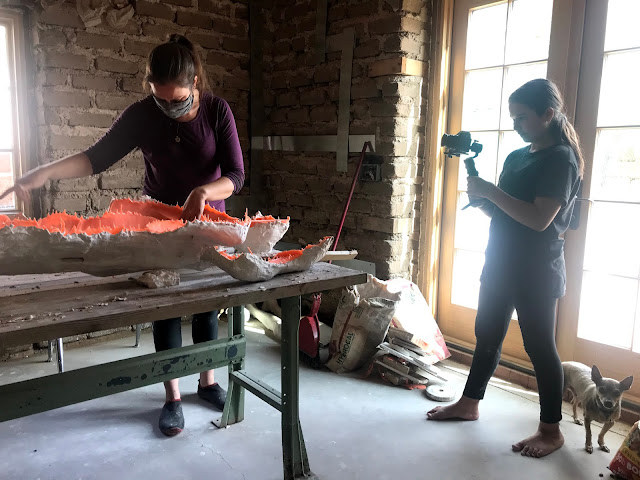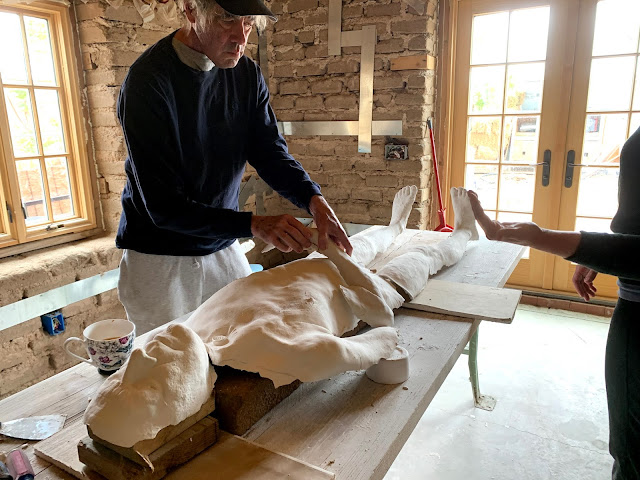I recently did an interview with Klassic International. The published interview leaves out my comments about the difficulty of making art in the age of Donald Trump's presidency. So here's the whole thing:
NEW Artist Interview
Klassic Magazine
Name: MARK HORST
Age: OLD
College: Carleton College, Yale University
How would you define yourself as an artist?
I’m a painter and more recently a sculptor. My art is a way of engaging the world, of paying attention.
What experience of your life would you say that is reflected in your works of art?
My interest in the human body, and especially the male form, is a way of responding to the years during which I was ashamed of my own body and my sexuality. So painting the male figure has been a long and slow work of healing old wounds and acknowledging the gift of my own body. Doing this work has also opened my art practice to new things. For some time now, I’ve been fascinated with the silhouettes of trees. Why is that? I’m not sure. Maybe I come from a long line of windblown cottonwoods.
Why are you an artist, and when did you first become one?
From the time I was young, drawing was a vehicle for my imagination. It felt good to me to make shapes with pencil and to copy illustrations I liked. When I was old enough—14—I built a potters wheel and a kiln and really devoted myself to learning the work of a potter. In college I worked at etching for a while. Eventually I gave it all up and decided it wasn’t practical. It wasn’t for another 20 years that I went back to figure drawing and eventually painting.
I am an artist because something in me isn’t satisfied with words and thoughts alone. I need t engage the world in a more primal, elemental way. Pencil, charcoal, conte crayon, oil paint, plasma cut steel—these are simple but powerful vehicles for probing and exposing something alive. They’re a way of hearing the pulse of life.
What art do you most identify with?
Truthfully I am a little disenchanted with art at the moment. It collects dust. It gets bought and sold for reasons that don’t have very much to do with what it is. It hangs on walls. Right now I’m most engaged by art that comes and goes and leaves no trace. And by art that creates a space to explore.
What themes do you pursue?
Its all just mud. But its never just mud. Where there’s life, the mud takes form and the light responds. And the world comes alive.
What inspires you to work? Where do you find inspiration?
Today I’m not feeling inspired at all. As a citizen of the US, the insanity of our President and his panderers has become such an oppressive cloud that I am finding art making to be very difficult. I am haunted by cries of immigrant children torn from their parents arms. I am haunted by the treachery and the corruption and the small mindedness and the absolute horror of our abuse of powerless people and the fragile earth.
When I am inspired it is because I’ve paid attention to something long enough—looked long enough and slowly enough or curiously enough to actually see something. Not just what I expect or want to see, but something surprisingly there. Something wonderfully there. Something to really love.
Would you tell us some things about yourself? Please include a few little known facts about you as well.
My son works in Havana, Cuba. When I first visited him, I took some conga lessons. So now playing the congas is a morning meditation for me. Its so good to do something that you can’t do easily. And to make a project of it. And the drumming feels like it comes up out of the earth.
What are you trying to communicate with your art?
I’m not. I don’t try to communicate anything. I try to pay attention.
What does “being creative” mean to you?
Being creative is about being alive. It means finding some way to crack through the sometimes hard shell of the world and find something worth treasuring, worth touching. To me its a form of intimacy with trees and bodies and people’s stories. Its a way of not accepting the capitalistic notion that everything depends on getting more and holding on to it. What a sad way to spend our time here.
Any shows, galleries, or publications where our readers can find your work?
Just look at my website: www.markhorststudio.com
How do you cultivate a collector base?
I am very lazy in some ways. And I’ve been fortunate to work with galleries that have sold enough work to keep me going. So I haven’t put much energy into cultivating collectors.
Which is your most cherished piece?
Well today my favorite piece of work is a drawing I did of chicken feet when I was working in Oaxaca. I just lined up 20 chicken feet and painted them and their shadows. There’s quite a lot missing here. And it makes me think.
If you had an exclusive collective exhibition with other artists work, who would you choose?
Today, I would choose to project my work while a really good conguero gave a concert.
Should art be funded? Why?
I’m actually grateful for the opportunity to do some large murals and sculpture—and these projects are often funded by some government entity. The chance to do this kind of work has taken a lot of pressure off gallery sales for me, so I don’t know it its right, but I’m grateful for it.
What famous artists have influenced you, and how?
When I was a boy, my parents had a lot of cheap, faded reproductions of Rembrandt paintings around. I loved them or maybe I should say I felt loved by them. So his work has always appealed to me and maybe fed my career long love of shadows and light. Marlene Dumas set me free in a way, through her use of contemporary media as source material and her messy drippy drawings. Oddly, I love Robert Irwin and his minimalist installations. Kengo Kuma’s achitecture makes me think of the spaces around me in new ways.
You seem to be very aware of the history of works. Where do you see films, photo exhibitions, art perfomances today?
Albuquerque has a great latin-fed music scene. Some of my favorite music shows up at bars here. But I miss lots of good stuff. My wife drags me to many great Bollywood openings here. Visual art is all around, but some of the best exhibitions I’ve seen recently have been in Havana.
What do you see as the strengths of your pieces, visually or conceptually?
Oh god, don’t make me talk about my work. Isn’t that your job? The pieces of mine I like the most are probably the most simple or clean. Pieces I have around because no one wants to buy them. Silhouettes of complex forms have an irrational hold on me. Paint scraped with a squeegee makes my heart sing.
What aspect of your work do you pay particular attention to?
Does it feel alive? There’s a religious tradition that holds that looking at the dead is disrespectful and that they should therefore be covered. I ask myself, is this thing alive or not? If not, either get rid of it or keep going.
What role does the artist have in society?
I think every artist plays her own role. Some of us need to keep our distance from social issues and some of us find art to be the vehicle we need to engage specific causes. Some of us are given the work of protecting unnoticed and sacred things that societies tend to trample on. Some of us are given a particular gift that just need to shine. So lots of roles and plentiful, wide-ranging work.
What is your most treasured memory?
I have a persistent and beautiful memory of holding my daughter on my lap when she was two years old. I was sitting in a chair in the kitchen and the winter sun was streaming in so that I had to squint. She was playing and laughing but all could see was this bright light glistening and sparkling over her as she moved in front of me. Dang, you ask some personal questions!
What for you is the most enjoyable part of your art?
My studio is in the old bakery of a former girls boarding school. It has these gorgeous tall windows that wrap around it. The opportunity to go into this beautiful room each morning and let my curiosity move me through the day is a great gift.
Some short questions now:
Colours: a color doesn’t mean anything until you put it next to another one.
Textures: something to let the shadows in.
Define your art: I wreck paintings.
Describe your style: messy
"Define yourself”
Prizes: I don’t get them. Could you give me one?
Art Fairs: painful.
Museums: University of New Mexico. Albuquerque Museum, Tamarind Institute
Cities: Acoma—the sky city—is my favorite place in the world.
Travels: Tamil Nadu. Kerala. Tiruvannamalai.
Artists: Richter, Banksy, Twombly,
Music:Prince. Manu Chau.
Cars: electric please…
Drones: sound like weed cutters in the sky
Mobile App: The Salsa Beat Machine.
How would your life change if you were no longer allowed to create art? I would be dead.
What do you think about the art community and market? Nothing.
Which of your projects has given you the most satisfaction?
I just finished a mural that I like very much. In two days I’m building a temporary installation that features my partner’s hand dyed silk. That’s satisfying.
Who are the writer's you admire the most? Cormac McCarthy.
What about architects and designers?
For some reason I keep finding myself looking at Kengo Kuma and Tadao Ando.
What else are you working on at the moment? Next projects?
I have another mural that I’m hoping someone will pay me to paint. I’ve been playing with lacy cut steel that I hope will get to be built. In the mean time I’m filling my studio with laser cut paper.
Share something you would like the world to know about you?
You don’t have to remember my name.
MEDIA NEWS Klassik Magazine International
















